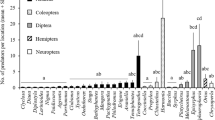Abstract
Pest and disease interactions in agroforestry systemsis a little studied area.Surveys were conducted in the Mangochi and Zomba districts of southern Malawi between December 1997 and February 1998 to identify insects feeding on Sesbania species in natural stands and in agroforestry systems at the research station and on farms, and the host range of the insects. Out of a total of 30 insect species recorded in natural stands, Brachyplatys testudonigro, Mesoplatys ochroptera, Exosoma sp. and Ootheca sp. were the most commonly found insects feeding on S. sesban. Afrius figuratus, Glypsus conspicuus, Macrorhaphis acuta, Mecosoma mensor, Rhinocoris segmentarius and Cyaneodinodes faciger were recorded for the first time as natural enemies of Mesoplatys ochroptera in Malawi. The defoliating beetles, M. ochroptera, Exosoma sp. and Ootheca sp., were the most frequently found insects infesting S. sesban on farms. M. ochroptera attacked only Sesbania species, and usually higher populations of this beetle were recorded on annual Sesbania species (S. tetraptera, S. bispinosa, S. leptocarpa and S. sericea) than on perennial types. Although the sap-sucking bug, B. testudonigro, was relatively less common on sesbania on farms, it has been found to infest a number of other legumes of the genera Aeschynomene, Crotalaria, Desmodium, Indigofera, Mucuna, Phaseolus, Tephrosia and Vigna. Given the wide variety of plant species it attacks, B. testudonigro may become a potential pest of many agroforestry tree species. The insects Anoplocnemis curvipes, Aphis fabae, Hilda patruelis, Megaleurothrips sjostedti, Mylabris dicincta, Nezara viridula and Ootheca sp. also have the potential to become pests of agroforestry systems, as they can damage many agroforestry trees, including Sesbania, and crops. There is a need to study the biology and ecology of potential insect pests of S. sesban to plan for their integrated management in agroforestry.
Similar content being viewed by others
References
Bohlen E (1973) Crop Pests in Tanzania and their Control. Verlag Paul Parey, Berlin, 142 pp
Drummond RB (1972) List of Rhodesian legumes. Kirkia 8: 209–230
Evans DO and Rotar PP (1987) Sesbania in Agriculture. Westview Press, Boulder, Colorado, 197 pp
Gillett JB (1963) Sesbania in Africa (excluding Madagascar) and southern Arabia. Kew Bulletin 17: 19–159
Harris WV (1936) Annotated list of insects injurious to cotton in Tanganyika. Bulletin of Entomological Research 27: 523–531
Harris WV (1937) Annotated list of insects injurious to native food crops in Tanganyika. Bulletin of Entomological Research 28: 483–488
Hill DS (1975) Agricultural Insect Pests of the Tropics and Their Control. Cambridge University Press, Cambridge, UK, 516 pp
Huxley PA and Greenland DJ (1989) Pest management in agroforestry systems: A record of discussions held at CABI, Wallingford, UK, 28–29 July 1988. Agroforestry Abstracts 2(2): 37–46
ICRAF (1995) Annual Report for 1994. International Centre for Research in Agroforestry, Nairobi, Kenya, 240 pp
Kwesiga F and Beniest J (1998) Sesbania Improved Fallows for Eastern Zambia: An Extension Guideline. International Centre for Research in Agroforestry, Nairobi, Kenya, 55 pp
Kwesiga F and Coe R (1994) The effect of short rotation Sesbania sesban planted fallows on maize yield. Forestry Ecology and Management 64: 199–209
Kwesiga FR and Ngugi DN (1996) Agroforestry research in the miombo ecozone: Experience of the southern Africa AFRENA. In: Mugah JO (ed) People and Institutional Participation in Agroforestry for Sustainable Development, pp 111–140. Kenya Forestry research Institute, Muguga, Nairobi, Kenya
Lee RF (1971) A preliminary annotated list of Malawi forest insects. Research Record No. 40, Forestry Research Institute of Malawi, Zomba, 132 pp
Mchowa JW and Ngugi DN (1994) Pest complex in agroforestry systems: The Malawi experience. Forest Ecology and Management 64: 277–284
Murphy ST (1990) Pests of Sesbania species and Sesbania species as pests: A review. In: Maclin B and Evans DO (eds) Perennial Sesbania Species in Agroforestry Systems, pp 123–130. Special Publication (90-01), Nitrogen Fixing tree Association, Waimanalo, Hawaii, USA
Ndungu JN and Boland DJ (1994) Sesbania seed collection in southern Africa: Developing a model for collaboration between a CGIAR Centre and NARS. Agroforestry Systems 27: 129–143
Niang A, Gathumbi S and Amadalo B (1996) The potential of short-duration improved fallow for crop productivity enhancement in the highlands of western Kenya. In: Mugah JO (ed) People and Institutional Participation in Agroforestry for Sustainable Development, pp 218–230. Kenya Forestry Research Institute, Muguga, Nairobi, Kenya
Onim JF, Otieno MK and Dzowela B (1990) The role of Sesbania as a multipurpose tree in small scale farms in western Kenya. In: Maclin B and Evans DO (eds) Perennial Sesbania Species in Agroforestry, pp 167–179. Nitrogen Fixing Tree Association, Waimanalo, Hawaii, USA
Singh Rathore MP (1995) Insect Pests in Agroforestry. Working Paper No. 70. ICRAF, Nairobi, Kenya, 73 pp
Smee C (1935) Report of the entomologist. Department of Agriculture of Nyasaland, Forestry Research Institute of Malawi, Zomba, pp 23–25
Snapp SS, Mafongoya PL and Waddington S (1998) Organic matter technologies for integrated management in smallholder cropping systems of southern Africa. Agriculture, Ecosystem and Environment 71: 185–200
Steinmüller N (1995) Agronomy of the nitrogen fixing fodder tree Sesbania sesban (L.) Merril and Sesbania goetzii Harms in the Ethiopian highlands. Verlag Ulrich E. Grauer, Stuttgart, Germany, 230 pp
Wale M, Abate A and Tesfaye A (1996) Getting to know the enemy – Mesoplatys beetles and sesbania. Agroforestry Today 8(3): 17–18
Wightman JA and Wightman AS (1994) An insect, agronomic and sociological survey of groundnut fields in southern Africa. Agriculture, Ecosystem and Environment 51: 311–331
Author information
Authors and Affiliations
Corresponding author
Rights and permissions
About this article
Cite this article
SIleshi, G., Maghembe, J., Rao, M. et al. Insects feeding on Sesbania species in natural stands and agroforestry systems in southern Malawi. Agroforestry Systems 49, 41–52 (2000). https://doi.org/10.1023/A:1006378713271
Issue Date:
DOI: https://doi.org/10.1023/A:1006378713271



